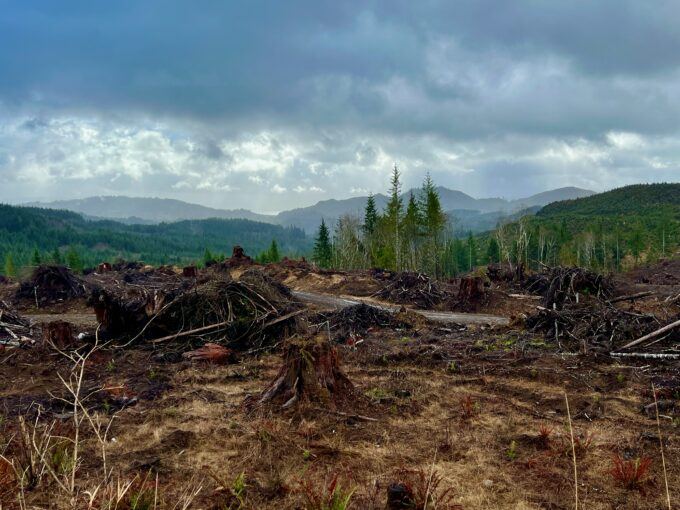Emergency Forest Cutting Will Exacerbate Wildfires

Logging site in the Oregon Coast Range. Photo: Jeffrey St. Clair.
On April 3rd, the Secretary of Agriculture, Brooke Rollins, issued an Emergency Order (EO) to accelerate logging on national forest lands. The alleged emergency is the presumed increase in wildfires across the West.
Unfortunately, most of the rationales for this “emergency” are based on flawed assumptions about “active” management (better known as logging) and the purported increase in wildfires.
The EO states that: “National Forests are in crisis due to uncharacteristically severe wildfires, insect and disease outbreaks, invasive species, and other stressors whose impacts have been compounded by too little active management.”
Despite recent years of significant wildfires, the overall acreage charred is less than in historical conditions. To quote from one recent study:
“Our results indicate, despite increasing area burned in recent decades, that a widespread fire deficit persists across a range of forest types and recent years with exceptionally high area burned are not unprecedented when considering the multi-century perspective offered by fire-scarred trees.”
The Secretary gets away with such misleading assertions by using a concept known as a sliding baseline. If you were to compare the acres of high-severity fires with those of the 1970s, they would have increased. However, this overlooks the fact that between 1940 and 1988, the overall climate of the West was cooler and moister.
What happens if the climate is cooler and moister? You have fewer ignitions and less fire spread.
However, if you look back further in the fire record than the 1970s, you will find that during periods of drought, the acreage burned by wildfires is significantly higher. During the “Dust Bowl” years of the late 1920s-early 1930s, as many as 50 million acres were burned across the West.
We are currently experiencing extreme weather characterized by high temperatures and severe drought, primarily attributed to human-induced carbon emissions into the atmosphere. Climate is the controlling factor in increases in wildfires and insects, such as bark beetles. To quote from the above study: “wildfire area burned (WFAB) in the American West was controlled by climate during the 20th century (1916–2003).”
Furthermore, rather than compounding fire severity and insect outbreaks, as claimed by the Secretary, active management, particularly logging, compounds the influence of climate change.
For example, a review study examining 1,500 wildfires found that the percentage of high-severity fires was highest in areas with “active management. “In contrast, lands where logging and other active management practices are excluded, such as wilderness areas and national parks, had lower levels of high-severity burns.
There is a reasonable explanation for these findings. When you log the forest, the canopy opens to greater sun dries soils and surface fuels. This means trees suffer from what is essentially dehydration and are far more flammable.
Thinning the forest also allows for greater wind penetration. High winds accounted for rapid fire spread. High winds, in particular, can throw embers over or around any “fuel reductions,” essentially making thinning or prescribed fires ineffective.
And while the Secretary suggests that invasive species are problematic, he neglects to mention that logging roads are one of the primary vectors for spreading weeds and disease into the forest.
When all is said and done, the best way to protect our national forests is not to promote “active management” but to reduce it.
Our forests have existed for millions of years, long before humans colonized the continent to manage them. And one has to presume that if they survived for tens of millions of years without human intervention, they certainly don’t need any now.
No comments:
Post a Comment